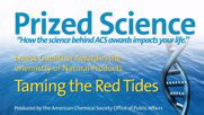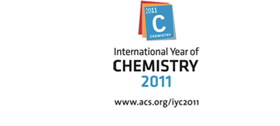FOR IMMEDIATE RELEASE | December 15, 2010
New American Chemical Society Prized Science video on “red tide” shellfish poisoning
WASHINGTON, Dec. 15, 2010 — The quest to cure a terrible form of food poisoning caused by population explosions of algae that stain the water red and produce a potent toxin is the topic of a new episode in the American Chemical Society (ACS) Prized Science video series.
Entitled “Taming the Red Tides,” the high-definition video, released today, focuses on Michael Crimmins, Ph.D., winner of the 2010 Ernest Guenther Award in the Chemistry of Natural Products. Crimmins, a chemist at the University of North Carolina in Chapel Hill, studies brevetoxin A, a poison produced by red tide algae.
Media Contact
Michael Bernstein
202-872-6042
m_bernstein@acs.org
Michael Woods
202-872-6293
m_woods@acs.org
The video explains that red tides perhaps were first documented in the Book of Exodus in the Holy Bible: “…and all the waters that were in the [Nile] river were turned to blood. And the fish that was in the river died; and the river stank, and the Egyptians could not drink of the water of the river ...”
Red tides occur when certain algae “bloom” in enormous numbers, staining the water reddish brown. Toxins, or poisons, released by the algae periodically kill millions of fish, and cause billions of dollars in losses to the global commercial fishing industry.
Health officials ban fishing for oysters, shrimp and other shellfish ― if they detect a red tide. If not, unsuspecting consumers may get hit with a virtual tidal wave called neurotoxic shellfish or paralytic shellfish poisoning. The condition causes not just nausea and vomiting, but tingling of the mouth, arms and legs, poor coordination, and other unpleasant symptoms. The algae can also produce a toxic mist, swept along by the wind like fog. People along the beach or in ships can become sick simply by inhaling this contaminated sea mist. Crimmins and his colleagues have been gathering knowledge about brevetoxin A, and related toxins, essential for developing medicines to treat the poisoning.
“Taming the Red Tides” is the fourth episode in Prized Science: How the Science Behind ACS Awards Impacts Your Life, from the American Chemical Society (ACS), the world’s largest scientific society. Rich with high-definition graphics and animations, and commentary suitable for classroom use and other audiences of students and non-scientists, the videos are available without charge at the Prized Science website, YouTube, iTunes and on DVD.
ACS encourages educators, schools, museums, science centers, news organizations, and others to embed links to Prized Science on their websites.
“Estimates suggest that more than 30,000 significant prizes ― most for scientific or medical research ― are awarded annually,” noted ACS President Joseph S. Francisco, Ph.D. “For many of them, the spotlight of news media publicity rightly focuses on the recipients. Often lost behind the headlines, is an explanation of how the science honored in the award impacts the everyday lives of people throughout the world. That is Prized Science’s goal, to give greater visibility to the science that won the prize. In doing so, Prized Science strives to give people who may have no special scientific knowledge, the opportunity to watch, listen, and discover how the chemistry behind ACS’ awards transforms life.”
“Taming the Red Tides” joins Prized Science episodes on:
• “Are We All From Mars?” Featuring Richard Zare, Ph.D., winner of the 2010 Priestley Medal, highest honor bestowed by ACS. Zare is the Marguerite Blake Wilbur Professor in Natural Science at Stanford University. The video highlights Zare’s work on the possibility that life existed on Mars and seeded life on Earth; in developing the technology that helped scientists decode the human genome; and in pioneering efforts to enlist nanoparticles in medicine
• “Green Gasoline” Featuring Vincent D’Amico, Ph.D., Emiel van Broekhoven, Ph.D., and Juha Jakkula, Ph.D., winners of the ACS Award for Affordable Green Chemistry. They invented an environmentally friendly process for making a key ingredient of “green gasoline,” a greener motor vehicle fuel.
• “Shrinking the Computer Chip” Featuring Robert Miller, Ph.D., winner of the 2010 ACS Award for Chemistry of Materials, who helped develop materials that shrunk the size and boosted the power of computer chips.
The ACS administers more than 60 national awards to honor accomplishments in chemistry and service to chemistry. The nomination process involves submission of forms, with winners selected by a committee consisting of ACS members who typically are technical experts in the nominee’s specific field of research.
###



